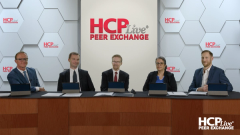
Efficacy of Teplizumab in Clinical Trials
Egils K. Bogdanovics, MD, and the expert panel review the TN10 study data on the efficacy of teplizumab in delaying the progression of T1D, which led to the drug’s approval from the FDA.
Episodes in this series

Steve Edelman, MD: Egils, we’ve talked about how to give teplizumab, and I think that was excellent because you don’t sit in the hospital for 14 days with 24 hours having an infusion. It’s 30 minutes. And I think even over time, they’re going to set up home health as you mentioned. Tell us the results of the TN10 study, which took a long time to recruit.
Egils K. Bogdanovics, MD: It took a long time.
Steve Edelman, MD: That single study led to the approval of teplizumab, and the FDA was very positive for getting this drug removed.
Egils K. Bogdanovics, MD: It’s the pivotal trial. Seventy-six patients. Half of them teplizumab, half of them saline. And all had 2 antibodies. Some had 3. The biggest effect was in the first year. After 1 year, the treatment group [showed] only 7% had stage III whereas for the placebo group it was about 44%. The median time to developing stage III in the treatment group was about 48 months and in the placebo 24 months. We’re talking about around 3 years of delayed diagnosis. If you told me that if getting an infusion every day will give me three weeks without diabetes, I would’ve taken it.
Steve Edelman, MD: Yeah, well, you’re different than someone without having type 1 diabetes. At the FDA hearing on the AdCom (advisory committee) panel, there was a cardiologist that was the lead advisor on this panel, who advises the FDA to approve or not to approve, and my blood boiled when he said, “Well, what’s the big deal delaying type 1 diabetes for 2 years?”
Schafer Boeder, MD: That’s a good point. Unfortunately, that’s the patient-centered outcomes that are so important, but we tend to kind of forget about that when we’re designing these trials and presenting with the FDA and they’re not really what the FDA is deciding this on, even though that’s important. To have weeks, months, or years without diabetes. That aside, 2, if you’re just looking at the outcomes it’s also important because the longer you can have beta cell function of any type, the longer you can make those beta cells work better, and the more likely you are to do well in the long term. It is another one of those examples of long-lasting metabolic effects, where it reduces your chance of complications, hypoglycemia, and glycemic variability. It’s meaningful both ways, but glad you brought up that patient perspective. It’s something we miss.
Linda A. DiMeglio, MD: I’ll also add that the longer term follow-up from that trial has shown that, because the trial ended but we continue to follow those people even now, and the longer-term paper showed a 32-month delay, so I think that keeps extending. It’s interesting that there seems to be a critical period, which you alluded to, where it works. There are people that were too far along, like there was this initial like non, like you couldn’t do much and it didn’t make a difference with the people that were on the cusp, but not quite there yet where the group that seemed to benefit and I agree. As somebody who does not live every day with type 1 diabetes, when people say to me, how can you expose people to risk for a modest benefit? I was like, I cannot judge the benefit and if you listen to that testimony from that, it blew me away. The effect and the fact that people were very passionate that this was a huge difference.
Steve Edelman, MD: You’re referring to the open public testimony?
Linda A. DiMeglio, MD: Yeah. The open public testimony was unbelievable.
Egils K. Bogdanovics, MD: Just hearing one day in the life of a type 1 diabetic really opens the eyes.
Justin M. Gregory, MD, MSCI: I’ll just add to that. It’s not just starting insulin, and Emily Sims did a great job in that, continuing to look at past the pivotal trial, it’s any insulin that the beta cell makes is helpful. Just think about how much better the honeymoon period is when you’re treating a patient compared to what happens after that, but it’s not just that. When you retain endogenous insulin secretion that means that you need to give less insulin into the peripheral circulation. We won’t talk about this at length, but insulin into the peripheral circulation does things that we don’t like. It causes increased weight gain. Keeping insulin coming from where it belongs, even if it’s just a small amount, has immense metabolic benefits. I think over the course of the next 5 years, we’re going to see that more.
Steve Edelman, MD: Yeah. Don’t forget the beta cell also secretes amylin. Amylin is a sister hormone to insulin and it has some important physiologic metabolic effects. And, as we know, there was a synthetic version of it approved called pramlintide. I thought it worked extremely well at dropping postprandial, but it was released a long time ago, you couldn’t get it in a form where you couldn’t mix it. It never really made it, but I do think its day is coming. It’s not just keeping the need for exogenous insulin down, you have this autoregulation that’s natural that helps keep the blood sugars in a normal range and prevents and improves variability.
Transcript edited for clarity
Newsletter
Access practical, evidence-based guidance to support better care for our youngest patients. Join our email list for the latest clinical updates.







